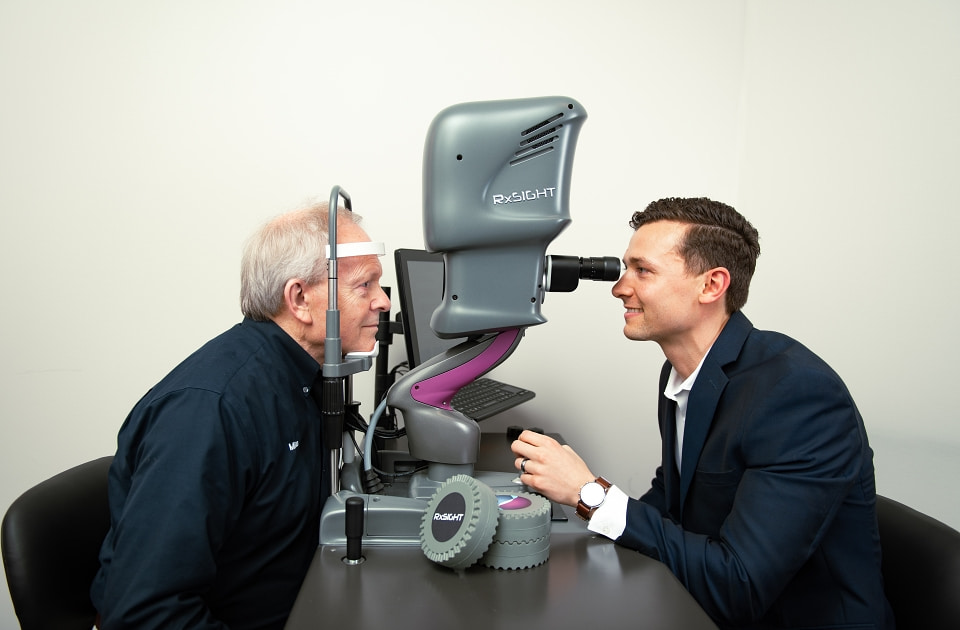Last updated: January 23rd, 2023
Cataracts are a common age-related eye condition: roughly one-half of Americans will develop cataracts by the age of 75, according to the National Eye Institute (NEI).1 Cataracts can cause clouding, blurred vision, and muted colors, and can make it difficult to drive at night. Fortunately, the eye care specialists at Praxis Vision have extensive experience in the treatment of cataracts. We employ state-of-the-art diagnostic tools and the most advanced options in customized cataract surgery.
What are Cataracts?
A cataract is the result of the accumulation of proteins on the inner lens of the eye, located behind the iris (the colored part of the eye). Eventually, this protein buildup causes the lens to become cloudy. A healthy, clear lens focuses light onto the retina at the back of the eye tCataracts are a normal part of the eye’s aging process, and cause clouding of the natural lens of the eye. As the cataract formation progresses and the natural lens of the eye slowly becomes more cloudy, it can feel as though a person is attempting to see through a window fogged with steam. For most people, the development of cataracts is very slow, and changes to their eyeglasses or contacts prescription may help them maintain clear vision for a while. Eventually, age-related cataracts will progress to the point where they interfere with daily activities. When this happens, cataract surgery is necessary.
Normal Eye

Eye with Cataracts

Symptoms of Cataracts
Symptoms of early age-related cataracts are often so mild that they go unnoticed. As the natural lens of the eye becomes more cloudy, people begin to notice vision problems. Common symptoms of cataracts include:
- Vision that is cloudy or blurry
- Light sensitivity
- Increased glare
- Colors that appear faded or yellowed
- Trouble driving at night
- Double vision in one eye
- Requiring brighter light to read
- Frequent changes to prescription for eyeglasses or contact lenses2
Risk Factors: Can Cataracts be Prevented?
Cataracts are a normal part of the eye’s aging process and cannot be prevented or reversed. Certain people, however, may have a greater risk of cataracts. Cataracts risk factors include:
- Age
- Family history of cataracts
- Diabetes
- Excessive sunlight exposure
- Obesity
- Smoking
- High blood pressure
- Eye injury or trauma
- Eye diseases
- Eye surgery
- Use of certain medications, like corticosteroids
- Excessive alcohol consumption
Types of Cataracts
There are a number of different types of cataracts, which are categorized according to the part of the eye’s lens they affect.
- Nuclear Cataracts cause clouding at the center of the lens. Nuclear cataracts that have progressed may turn the lens brown, changing the way a person sees colors.
- Cortical Cataracts cause clouding at the edges of the eye’s lens. These cataracts often initially appear as whitish marks or streaks on the outer edge of the lens. These white streaks gradually extend toward the center of the lens, interfering with the way light passes into the eye.
- Posterior Subcapsular Cataracts cause cloudiness near the back of the lens. This type of cataract can interfere with near vision and night vision, also causing glares or halos to appear around lights at night.
- Congenital Cataracts are cataracts that are present at birth. This very rare type of cataract may be genetic or caused by infection or birth trauma.3
How are Cataracts Diagnosed?
Cataracts are diagnosed during a painless eye examination. At Praxis Vision, we employ the very latest in ophthalmologic diagnostic tools. An eye exam that leads to cataract diagnosis may include:
- Visual acuity test
- Refractive test to evaluate your prescription for eyeglasses or contact lenses
- Retina health assessment
- Slit lamp examination
- Glare sensitivity testing
- Color vision testing
- Measurement of eye pressure (tonometry)
- Medical history review
- Conversation about your symptoms and vision changes


Cataracts Treatment
Cataracts progress gradually in most cases and patients may be able to postpone treatment for a while, but eventually the only way to treat clouding of the lens is cataract removal. During cataract surgery, the cloudy lens of the eye is removed and replaced with an artificial intraocular lens (IOL), restoring clear vision.4 Cataract surgery is one of the most frequently-performed procedures in the world and has an excellent success rate of over 99%.5
Intraocular Lens Implants (IOLs) for Cataract Surgery
At Praxis Vision, the state-of-the-art photoreactive material within the Light Adjustable Lens allows us to fine-tune the fit and shape of the IOLs after cataract surgery to achieve the most accurate vision correction possible.6,7
Standard vs Advanced IOLs
Traditionally, a standard IOL is used during cataract surgery. This artificial lens replaces the cloudy lens of the eye that has been clouded by cataracts, restoring clear vision. Standard IOLs, also referred to as monofocal IOLs, are covered by insurance for cataract surgery. However, a standard artificial lens will not correct refractive errors, which means that while the visual impairment from cataracts is removed, patients may still need to wear their eyeglasses or contacts.
At Praxis Vision, these premium lenses have been designed with advanced optics and materials, allowing our eye surgeons to correct refractive errors like nearsightedness (myopia), farsightedness (hyperopia), astigmatism, and age-related near vision loss (presbyopia). Many of our patients who undergo cataract surgery with advanced IOLs are able to reduce or even eliminate their dependence on eyeglasses or contacts.
Cataract Surgery: What to Expect
Preparing for Cataract Surgery
Following a cataracts diagnosis, your eye care provider will discuss your cataracts progression and the treatment options available to you. A staff member will help you schedule your cataract surgery and will also help you work with your insurance company.
Before cataract surgery, you may be asked to stop taking certain medications. You may also be prescribed eye drops to help prepare your eye for the procedure. You will be asked to refrain from eating before your surgery. You will not be able to drive immediately after cataract surgery, so you’ll need to make arrangements for transportation.
The Cataract Surgery Procedure
Cataract surgery is performed on one eye at a time, with procedures scheduled several weeks apart. This is a common outpatient procedure that takes only about 10 minutes to perform. You should expect to spend a few hours at our ambulatory surgery center, to account for intake, a brief eye exam, and a short recovery period after your procedure.
Before cataract surgery, your eye will be numbed with anesthetic eye drops. A device called a speculum will be used to hold your eye open and prevent you from blinking. While you recline comfortably, your ophthalmologist will remove the cloudy natural lens of your eye and replace it with an artificial lens. No sutures are needed after cataract surgery: the incision is so tiny that it naturally heals itself.
Immediately after cataract surgery you will recover briefly here at our surgery center. Shortly, you will be released to be driven home.
Recovery After Cataract Surgery
Immediately after cataract surgery, you may experience some blurry vision. This is normal and will resolve quickly. It is also normal to experience some soreness or a sensation of pressure, but you should not experience any pain.
Your eye doctor will prescribe antibiotic and anti-inflammatory eye drops for you to use after cataract surgery. Please follow administration instructions carefully.
Most of our patients are able to resume their normal daily routines within 24 to 48 hours of cataract surgery, including driving. We do ask that patients avoid swimming or strenuous activity for at least two weeks. Patients notice a rapid improvement in their vision after cataract surgery.
Contact Praxis Vision
If you have been diagnosed with cataracts or have vision problems like clouding that you suspect are related to cataracts, the eye health specialists at Praxis Vision can provide you with the most advanced level of customized cataract surgery available. To learn more about your treatment options, please contact us.

1 National Eye Institute. Cataract Data and Statistics. Available: https://www.nei.nih.gov/learn-about-eye-health/outreach-campaigns-and-resources/eye-health-data-and-statistics/cataract-data-and-statistics. Accessed October 21, 2021.
2 Cleveland Clinic. Cataracts. Available: https://my.clevelandclinic.org/health/diseases/8589-cataracts. Accessed October 21, 2021.
3 Mayo Clinic. Cataracts. Available: https://www.mayoclinic.org/diseases-conditions/cataracts/symptoms-causes/syc-20353790. Accessed October 21, 2021.
4 American Academy of Ophthalmology. Intraocular Implants (IOLs). Available: https://www.aao.org/eye-health/treatments/iols-intraocular-lens. Accessed October 21, 2021.
5 American Refractive Surgery Council. Cataract Surgery. Available: https://americanrefractivesurgerycouncil.org/cataract-surgery/. Accessed October 21, 2021.
6 American Academy of Ophthalmology. IOL Implants: Lens Replacement After Cataracts. Available: https://www.aao.org/eye-health/diseases/cataracts-iol-implants. Accessed October 21, 2021.
7 American Academy of Ophthalmology. Adjustable IOL Could Help Some Ditch Their Glasses After Cataract Surgery. Available: https://www.aao.org/eye-health/news/new-iol-adjustable-after-cataract-surgery?gclid=EAIaIQobChMI8NHr27nw6AIVSx-tBh0pRg6kEAMYASAAEgIzE_D_BwE. Accessed October 21, 2021.
